Communicating Across Cultures: A Comprehensive Report
VerifiedAdded on 2020/03/07
|15
|3801
|242
Report
AI Summary
This report provides a detailed analysis of communication across cultures in a global business context. It explores how cultural beliefs and values influence communication styles and how communication strategies must adapt to cultural differences. The report examines the impact of cultural diversity on business communication, organizational behavior, and intercultural communication. It delves into the importance of effective workplace communication, the influence of cultural values on organizational structures and employee commitment, and the skills necessary for working in diverse environments. The report discusses the challenges of interpersonal communication in cross-cultural settings, the factors increasing the significance of intercultural communication, and the impact of diversity on employee performance and conflict resolution. It emphasizes the need for organizations to manage cultural differences and adapt to the globalized business environment. The report also highlights the importance of interpersonal communication in building trust and fostering positive relationships within international companies.
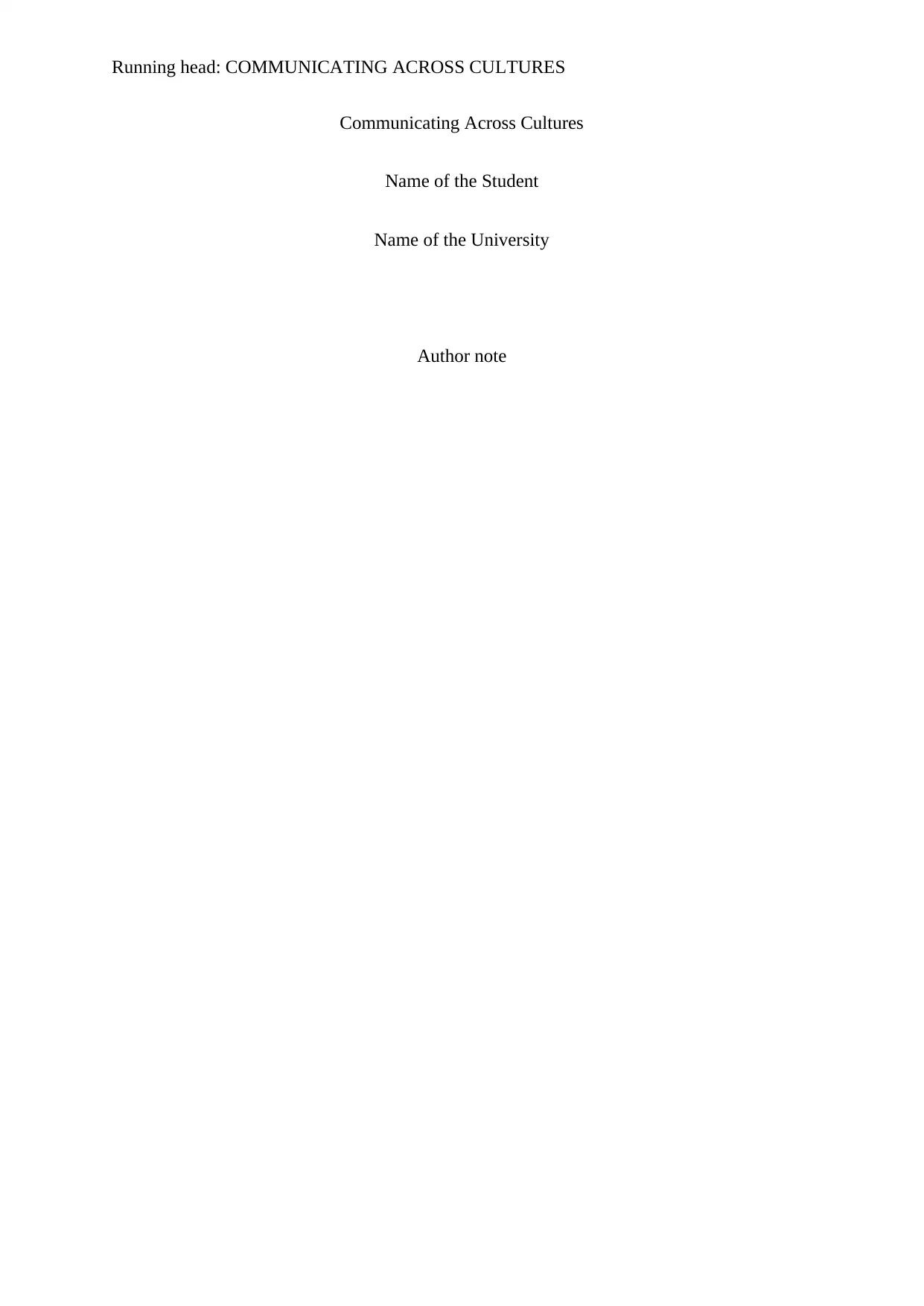
Running head: COMMUNICATING ACROSS CULTURES
Communicating Across Cultures
Name of the Student
Name of the University
Author note
Communicating Across Cultures
Name of the Student
Name of the University
Author note
Paraphrase This Document
Need a fresh take? Get an instant paraphrase of this document with our AI Paraphraser
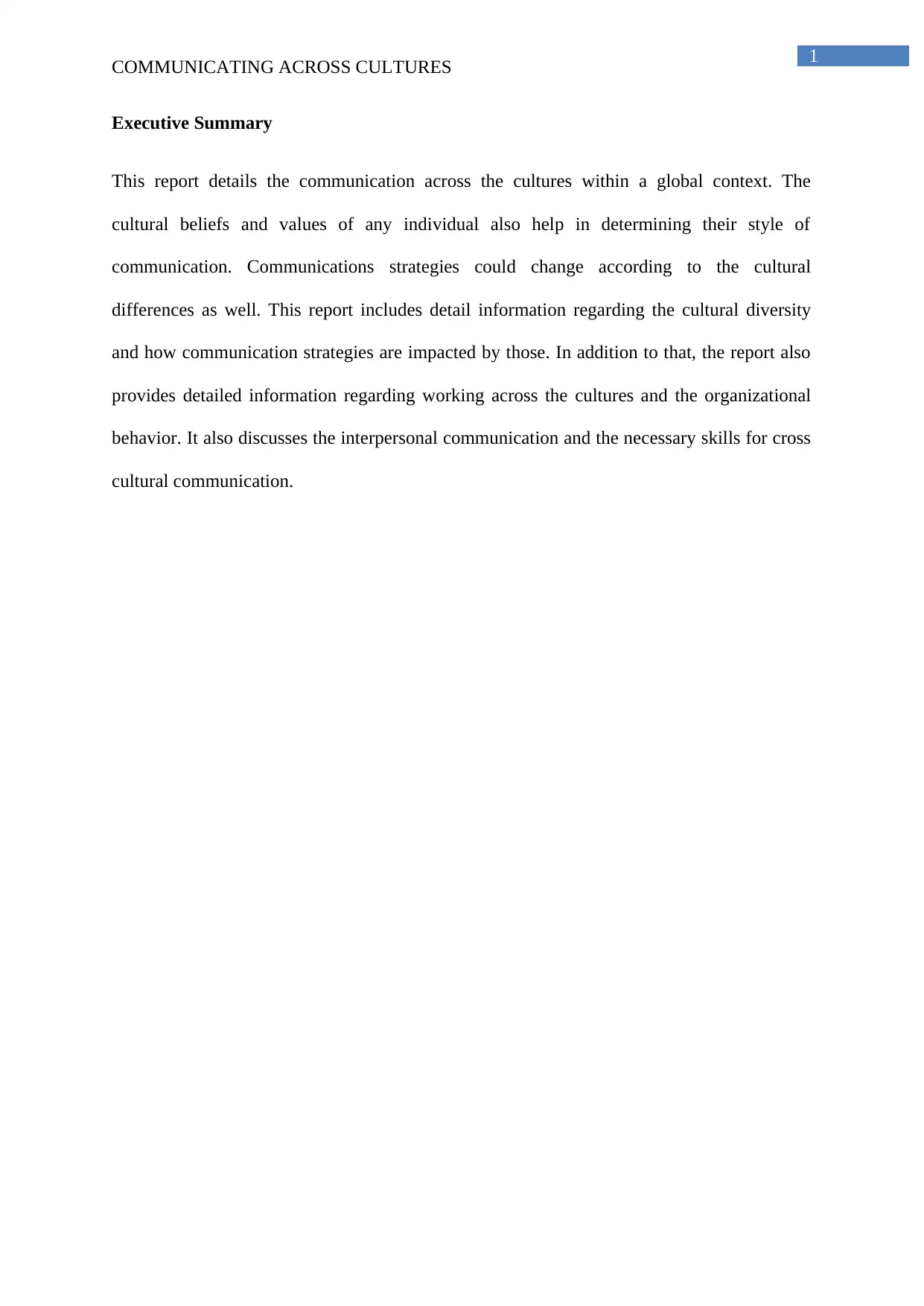
1
COMMUNICATING ACROSS CULTURES
Executive Summary
This report details the communication across the cultures within a global context. The
cultural beliefs and values of any individual also help in determining their style of
communication. Communications strategies could change according to the cultural
differences as well. This report includes detail information regarding the cultural diversity
and how communication strategies are impacted by those. In addition to that, the report also
provides detailed information regarding working across the cultures and the organizational
behavior. It also discusses the interpersonal communication and the necessary skills for cross
cultural communication.
COMMUNICATING ACROSS CULTURES
Executive Summary
This report details the communication across the cultures within a global context. The
cultural beliefs and values of any individual also help in determining their style of
communication. Communications strategies could change according to the cultural
differences as well. This report includes detail information regarding the cultural diversity
and how communication strategies are impacted by those. In addition to that, the report also
provides detailed information regarding working across the cultures and the organizational
behavior. It also discusses the interpersonal communication and the necessary skills for cross
cultural communication.
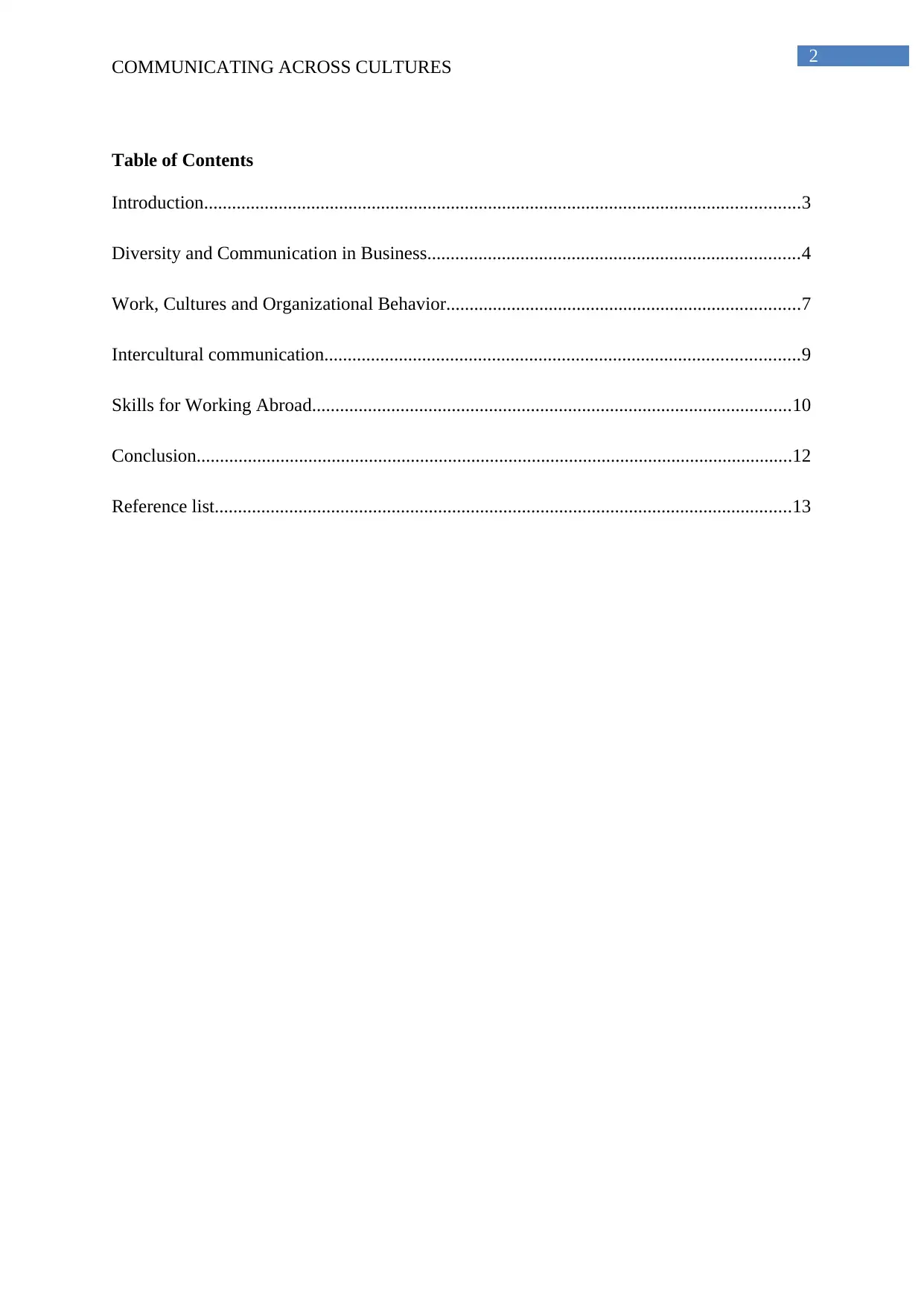
2
COMMUNICATING ACROSS CULTURES
Table of Contents
Introduction................................................................................................................................3
Diversity and Communication in Business................................................................................4
Work, Cultures and Organizational Behavior............................................................................7
Intercultural communication......................................................................................................9
Skills for Working Abroad.......................................................................................................10
Conclusion................................................................................................................................12
Reference list............................................................................................................................13
COMMUNICATING ACROSS CULTURES
Table of Contents
Introduction................................................................................................................................3
Diversity and Communication in Business................................................................................4
Work, Cultures and Organizational Behavior............................................................................7
Intercultural communication......................................................................................................9
Skills for Working Abroad.......................................................................................................10
Conclusion................................................................................................................................12
Reference list............................................................................................................................13
⊘ This is a preview!⊘
Do you want full access?
Subscribe today to unlock all pages.

Trusted by 1+ million students worldwide
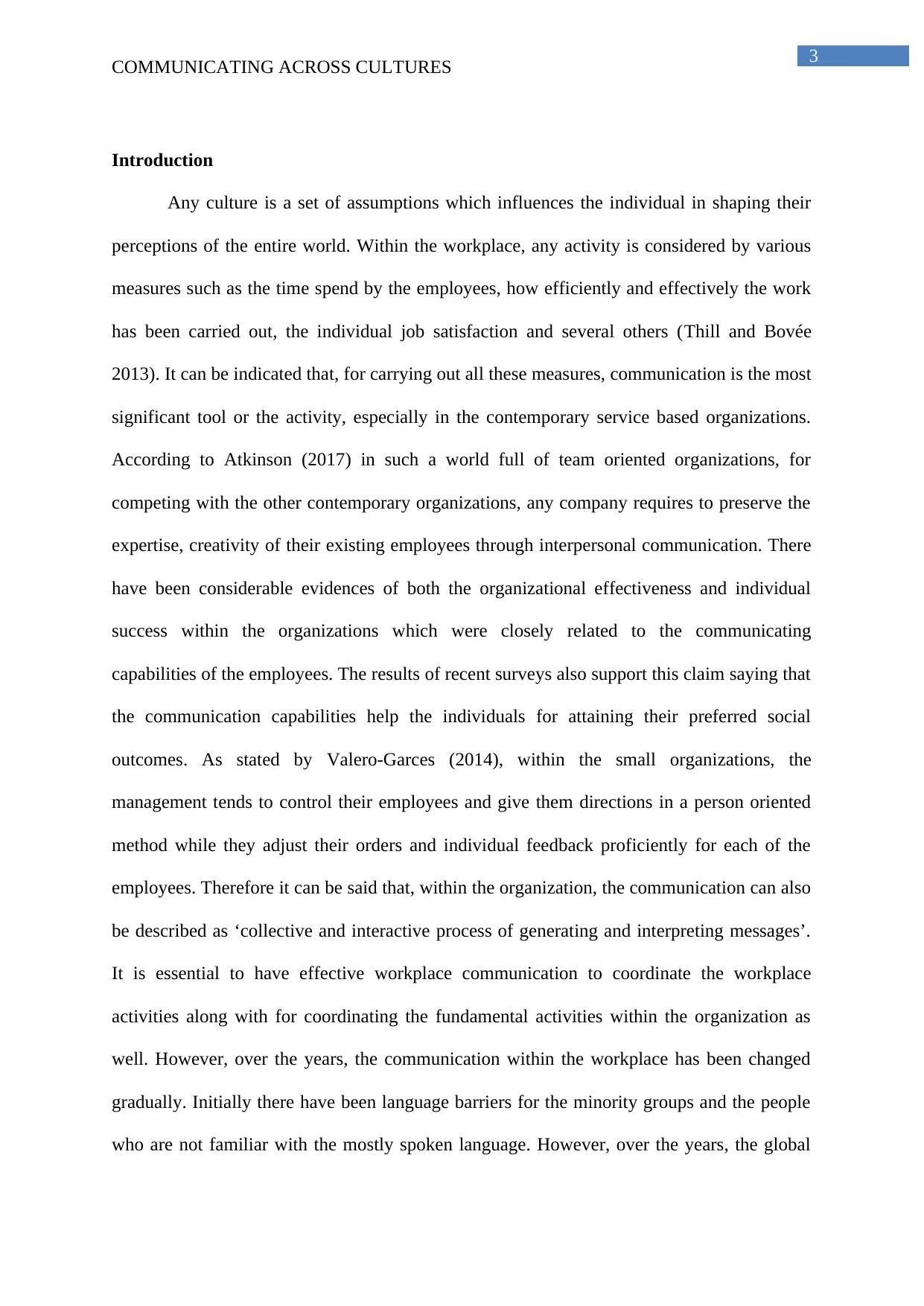
3
COMMUNICATING ACROSS CULTURES
Introduction
Any culture is a set of assumptions which influences the individual in shaping their
perceptions of the entire world. Within the workplace, any activity is considered by various
measures such as the time spend by the employees, how efficiently and effectively the work
has been carried out, the individual job satisfaction and several others (Thill and Bovée
2013). It can be indicated that, for carrying out all these measures, communication is the most
significant tool or the activity, especially in the contemporary service based organizations.
According to Atkinson (2017) in such a world full of team oriented organizations, for
competing with the other contemporary organizations, any company requires to preserve the
expertise, creativity of their existing employees through interpersonal communication. There
have been considerable evidences of both the organizational effectiveness and individual
success within the organizations which were closely related to the communicating
capabilities of the employees. The results of recent surveys also support this claim saying that
the communication capabilities help the individuals for attaining their preferred social
outcomes. As stated by Valero-Garces (2014), within the small organizations, the
management tends to control their employees and give them directions in a person oriented
method while they adjust their orders and individual feedback proficiently for each of the
employees. Therefore it can be said that, within the organization, the communication can also
be described as ‘collective and interactive process of generating and interpreting messages’.
It is essential to have effective workplace communication to coordinate the workplace
activities along with for coordinating the fundamental activities within the organization as
well. However, over the years, the communication within the workplace has been changed
gradually. Initially there have been language barriers for the minority groups and the people
who are not familiar with the mostly spoken language. However, over the years, the global
COMMUNICATING ACROSS CULTURES
Introduction
Any culture is a set of assumptions which influences the individual in shaping their
perceptions of the entire world. Within the workplace, any activity is considered by various
measures such as the time spend by the employees, how efficiently and effectively the work
has been carried out, the individual job satisfaction and several others (Thill and Bovée
2013). It can be indicated that, for carrying out all these measures, communication is the most
significant tool or the activity, especially in the contemporary service based organizations.
According to Atkinson (2017) in such a world full of team oriented organizations, for
competing with the other contemporary organizations, any company requires to preserve the
expertise, creativity of their existing employees through interpersonal communication. There
have been considerable evidences of both the organizational effectiveness and individual
success within the organizations which were closely related to the communicating
capabilities of the employees. The results of recent surveys also support this claim saying that
the communication capabilities help the individuals for attaining their preferred social
outcomes. As stated by Valero-Garces (2014), within the small organizations, the
management tends to control their employees and give them directions in a person oriented
method while they adjust their orders and individual feedback proficiently for each of the
employees. Therefore it can be said that, within the organization, the communication can also
be described as ‘collective and interactive process of generating and interpreting messages’.
It is essential to have effective workplace communication to coordinate the workplace
activities along with for coordinating the fundamental activities within the organization as
well. However, over the years, the communication within the workplace has been changed
gradually. Initially there have been language barriers for the minority groups and the people
who are not familiar with the mostly spoken language. However, over the years, the global
Paraphrase This Document
Need a fresh take? Get an instant paraphrase of this document with our AI Paraphraser
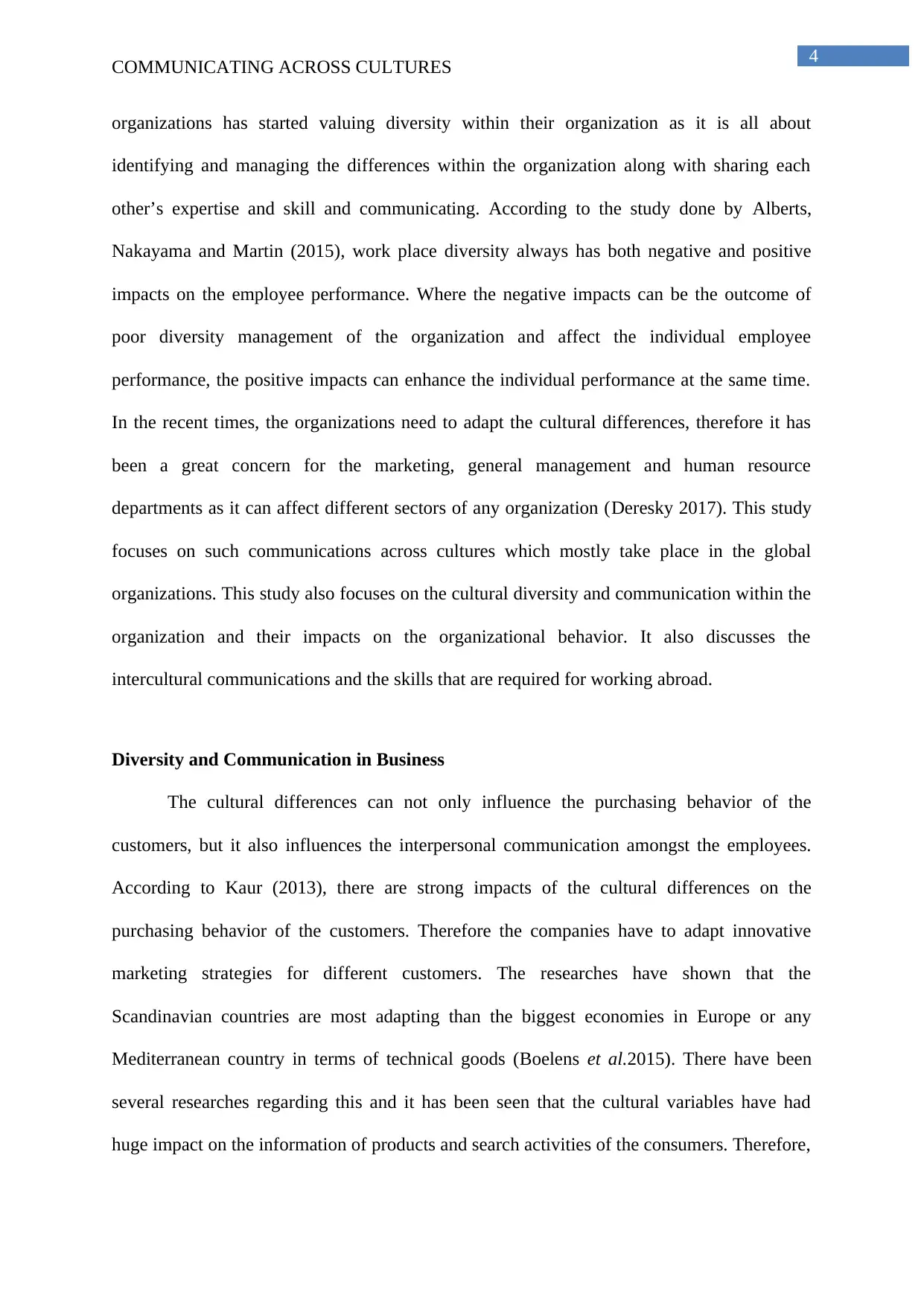
4
COMMUNICATING ACROSS CULTURES
organizations has started valuing diversity within their organization as it is all about
identifying and managing the differences within the organization along with sharing each
other’s expertise and skill and communicating. According to the study done by Alberts,
Nakayama and Martin (2015), work place diversity always has both negative and positive
impacts on the employee performance. Where the negative impacts can be the outcome of
poor diversity management of the organization and affect the individual employee
performance, the positive impacts can enhance the individual performance at the same time.
In the recent times, the organizations need to adapt the cultural differences, therefore it has
been a great concern for the marketing, general management and human resource
departments as it can affect different sectors of any organization (Deresky 2017). This study
focuses on such communications across cultures which mostly take place in the global
organizations. This study also focuses on the cultural diversity and communication within the
organization and their impacts on the organizational behavior. It also discusses the
intercultural communications and the skills that are required for working abroad.
Diversity and Communication in Business
The cultural differences can not only influence the purchasing behavior of the
customers, but it also influences the interpersonal communication amongst the employees.
According to Kaur (2013), there are strong impacts of the cultural differences on the
purchasing behavior of the customers. Therefore the companies have to adapt innovative
marketing strategies for different customers. The researches have shown that the
Scandinavian countries are most adapting than the biggest economies in Europe or any
Mediterranean country in terms of technical goods (Boelens et al.2015). There have been
several researches regarding this and it has been seen that the cultural variables have had
huge impact on the information of products and search activities of the consumers. Therefore,
COMMUNICATING ACROSS CULTURES
organizations has started valuing diversity within their organization as it is all about
identifying and managing the differences within the organization along with sharing each
other’s expertise and skill and communicating. According to the study done by Alberts,
Nakayama and Martin (2015), work place diversity always has both negative and positive
impacts on the employee performance. Where the negative impacts can be the outcome of
poor diversity management of the organization and affect the individual employee
performance, the positive impacts can enhance the individual performance at the same time.
In the recent times, the organizations need to adapt the cultural differences, therefore it has
been a great concern for the marketing, general management and human resource
departments as it can affect different sectors of any organization (Deresky 2017). This study
focuses on such communications across cultures which mostly take place in the global
organizations. This study also focuses on the cultural diversity and communication within the
organization and their impacts on the organizational behavior. It also discusses the
intercultural communications and the skills that are required for working abroad.
Diversity and Communication in Business
The cultural differences can not only influence the purchasing behavior of the
customers, but it also influences the interpersonal communication amongst the employees.
According to Kaur (2013), there are strong impacts of the cultural differences on the
purchasing behavior of the customers. Therefore the companies have to adapt innovative
marketing strategies for different customers. The researches have shown that the
Scandinavian countries are most adapting than the biggest economies in Europe or any
Mediterranean country in terms of technical goods (Boelens et al.2015). There have been
several researches regarding this and it has been seen that the cultural variables have had
huge impact on the information of products and search activities of the consumers. Therefore,
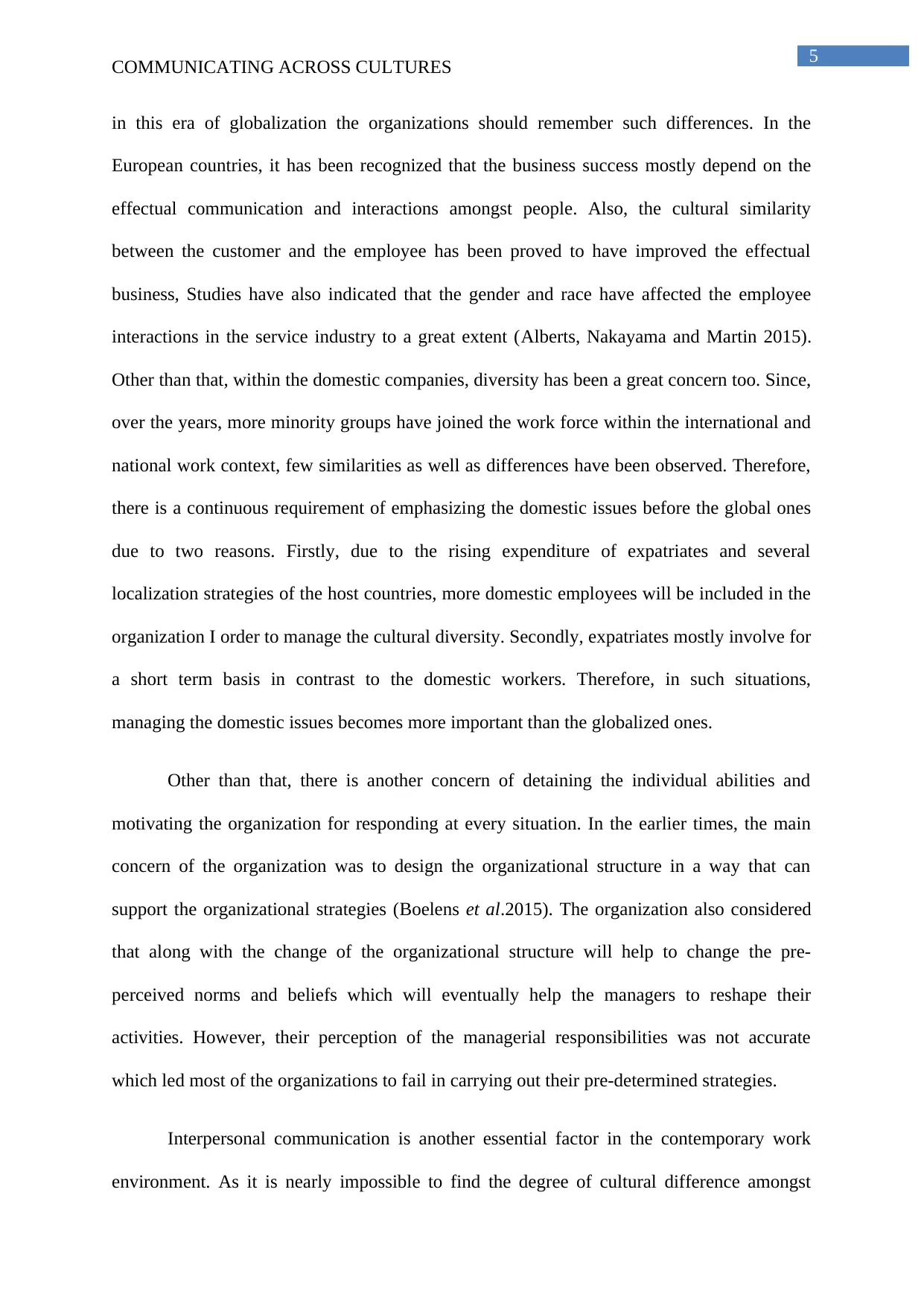
5
COMMUNICATING ACROSS CULTURES
in this era of globalization the organizations should remember such differences. In the
European countries, it has been recognized that the business success mostly depend on the
effectual communication and interactions amongst people. Also, the cultural similarity
between the customer and the employee has been proved to have improved the effectual
business, Studies have also indicated that the gender and race have affected the employee
interactions in the service industry to a great extent (Alberts, Nakayama and Martin 2015).
Other than that, within the domestic companies, diversity has been a great concern too. Since,
over the years, more minority groups have joined the work force within the international and
national work context, few similarities as well as differences have been observed. Therefore,
there is a continuous requirement of emphasizing the domestic issues before the global ones
due to two reasons. Firstly, due to the rising expenditure of expatriates and several
localization strategies of the host countries, more domestic employees will be included in the
organization I order to manage the cultural diversity. Secondly, expatriates mostly involve for
a short term basis in contrast to the domestic workers. Therefore, in such situations,
managing the domestic issues becomes more important than the globalized ones.
Other than that, there is another concern of detaining the individual abilities and
motivating the organization for responding at every situation. In the earlier times, the main
concern of the organization was to design the organizational structure in a way that can
support the organizational strategies (Boelens et al.2015). The organization also considered
that along with the change of the organizational structure will help to change the pre-
perceived norms and beliefs which will eventually help the managers to reshape their
activities. However, their perception of the managerial responsibilities was not accurate
which led most of the organizations to fail in carrying out their pre-determined strategies.
Interpersonal communication is another essential factor in the contemporary work
environment. As it is nearly impossible to find the degree of cultural difference amongst
COMMUNICATING ACROSS CULTURES
in this era of globalization the organizations should remember such differences. In the
European countries, it has been recognized that the business success mostly depend on the
effectual communication and interactions amongst people. Also, the cultural similarity
between the customer and the employee has been proved to have improved the effectual
business, Studies have also indicated that the gender and race have affected the employee
interactions in the service industry to a great extent (Alberts, Nakayama and Martin 2015).
Other than that, within the domestic companies, diversity has been a great concern too. Since,
over the years, more minority groups have joined the work force within the international and
national work context, few similarities as well as differences have been observed. Therefore,
there is a continuous requirement of emphasizing the domestic issues before the global ones
due to two reasons. Firstly, due to the rising expenditure of expatriates and several
localization strategies of the host countries, more domestic employees will be included in the
organization I order to manage the cultural diversity. Secondly, expatriates mostly involve for
a short term basis in contrast to the domestic workers. Therefore, in such situations,
managing the domestic issues becomes more important than the globalized ones.
Other than that, there is another concern of detaining the individual abilities and
motivating the organization for responding at every situation. In the earlier times, the main
concern of the organization was to design the organizational structure in a way that can
support the organizational strategies (Boelens et al.2015). The organization also considered
that along with the change of the organizational structure will help to change the pre-
perceived norms and beliefs which will eventually help the managers to reshape their
activities. However, their perception of the managerial responsibilities was not accurate
which led most of the organizations to fail in carrying out their pre-determined strategies.
Interpersonal communication is another essential factor in the contemporary work
environment. As it is nearly impossible to find the degree of cultural difference amongst
⊘ This is a preview!⊘
Do you want full access?
Subscribe today to unlock all pages.

Trusted by 1+ million students worldwide
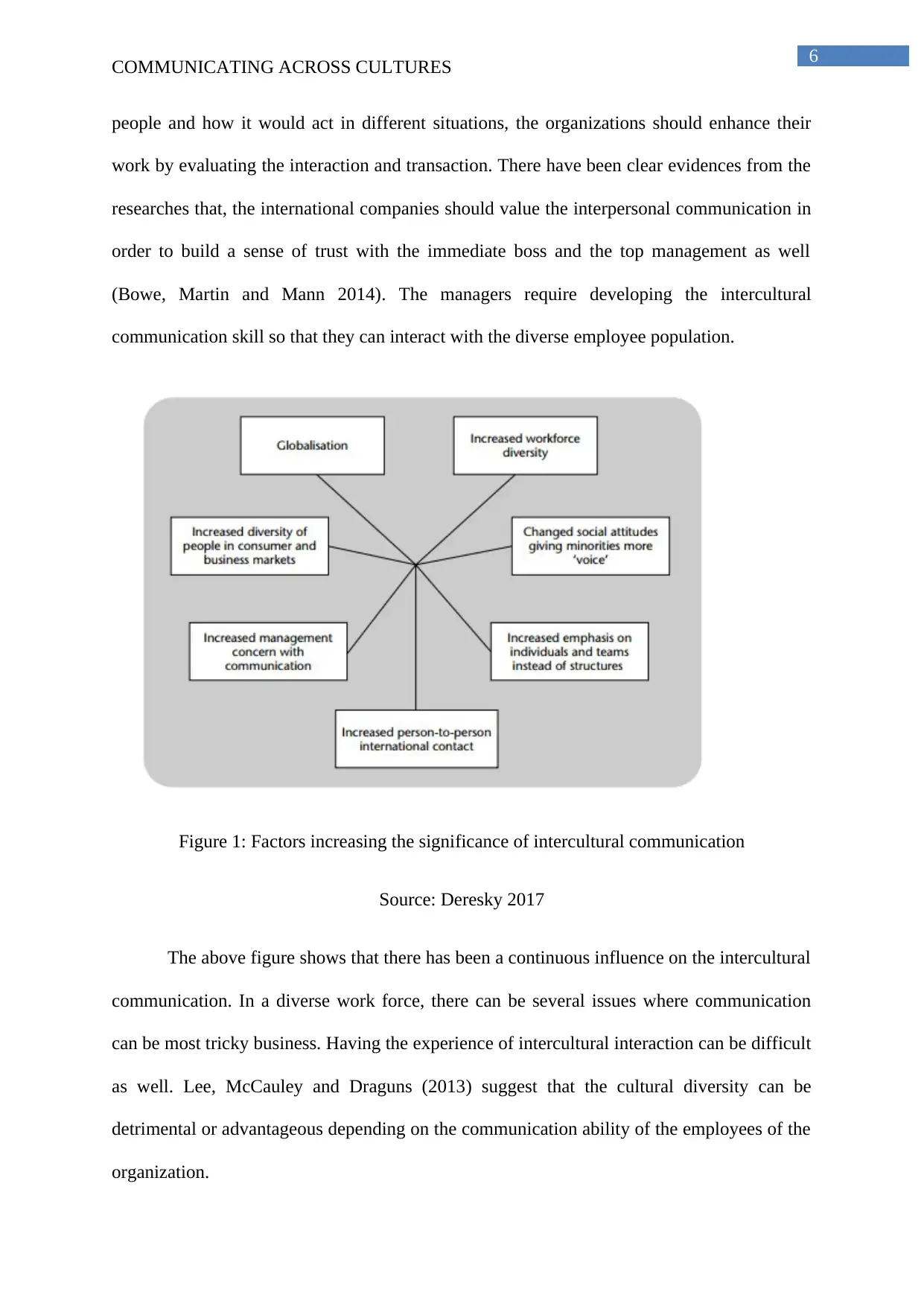
6
COMMUNICATING ACROSS CULTURES
people and how it would act in different situations, the organizations should enhance their
work by evaluating the interaction and transaction. There have been clear evidences from the
researches that, the international companies should value the interpersonal communication in
order to build a sense of trust with the immediate boss and the top management as well
(Bowe, Martin and Mann 2014). The managers require developing the intercultural
communication skill so that they can interact with the diverse employee population.
Figure 1: Factors increasing the significance of intercultural communication
Source: Deresky 2017
The above figure shows that there has been a continuous influence on the intercultural
communication. In a diverse work force, there can be several issues where communication
can be most tricky business. Having the experience of intercultural interaction can be difficult
as well. Lee, McCauley and Draguns (2013) suggest that the cultural diversity can be
detrimental or advantageous depending on the communication ability of the employees of the
organization.
COMMUNICATING ACROSS CULTURES
people and how it would act in different situations, the organizations should enhance their
work by evaluating the interaction and transaction. There have been clear evidences from the
researches that, the international companies should value the interpersonal communication in
order to build a sense of trust with the immediate boss and the top management as well
(Bowe, Martin and Mann 2014). The managers require developing the intercultural
communication skill so that they can interact with the diverse employee population.
Figure 1: Factors increasing the significance of intercultural communication
Source: Deresky 2017
The above figure shows that there has been a continuous influence on the intercultural
communication. In a diverse work force, there can be several issues where communication
can be most tricky business. Having the experience of intercultural interaction can be difficult
as well. Lee, McCauley and Draguns (2013) suggest that the cultural diversity can be
detrimental or advantageous depending on the communication ability of the employees of the
organization.
Paraphrase This Document
Need a fresh take? Get an instant paraphrase of this document with our AI Paraphraser
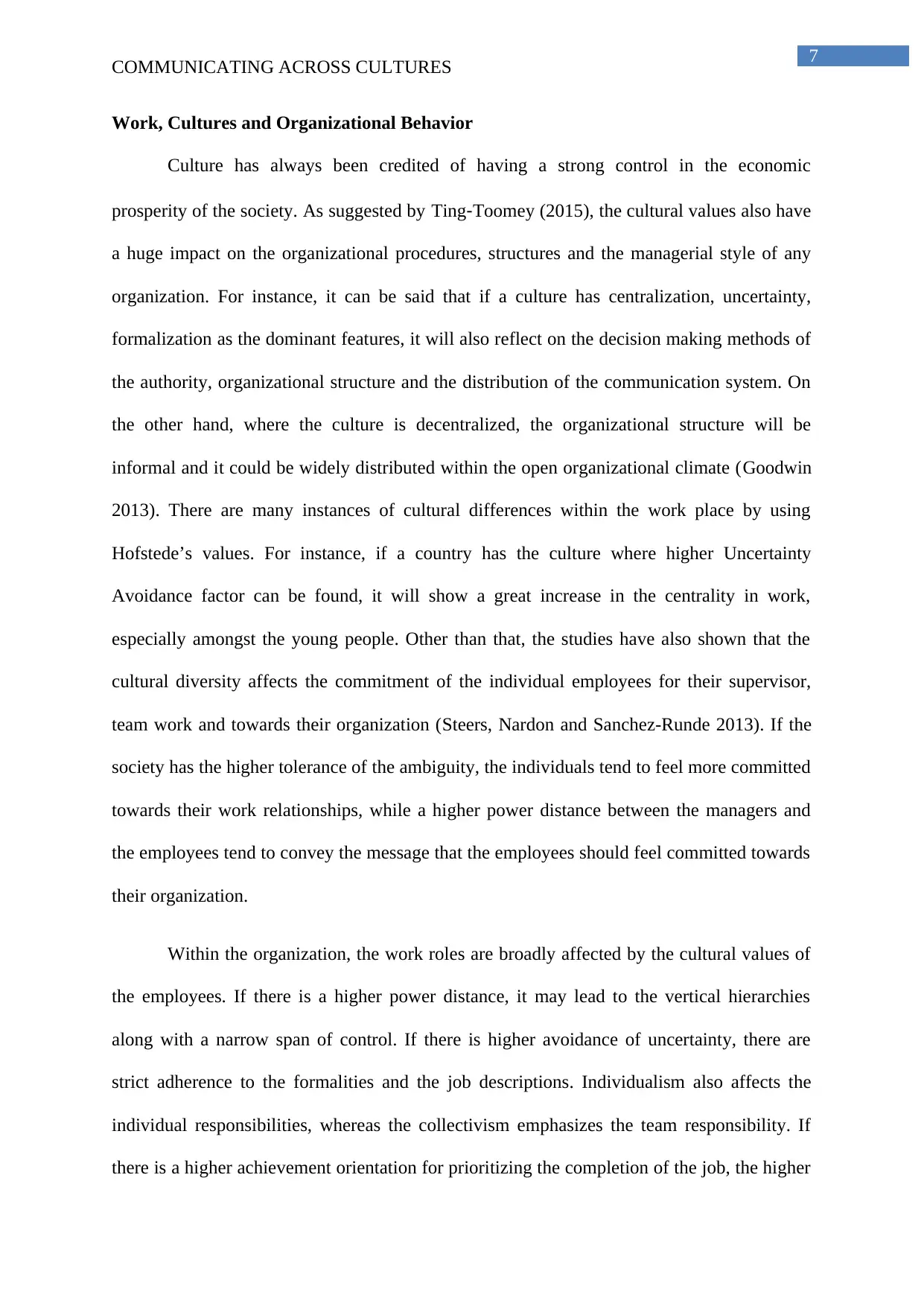
7
COMMUNICATING ACROSS CULTURES
Work, Cultures and Organizational Behavior
Culture has always been credited of having a strong control in the economic
prosperity of the society. As suggested by Ting‐Toomey (2015), the cultural values also have
a huge impact on the organizational procedures, structures and the managerial style of any
organization. For instance, it can be said that if a culture has centralization, uncertainty,
formalization as the dominant features, it will also reflect on the decision making methods of
the authority, organizational structure and the distribution of the communication system. On
the other hand, where the culture is decentralized, the organizational structure will be
informal and it could be widely distributed within the open organizational climate (Goodwin
2013). There are many instances of cultural differences within the work place by using
Hofstede’s values. For instance, if a country has the culture where higher Uncertainty
Avoidance factor can be found, it will show a great increase in the centrality in work,
especially amongst the young people. Other than that, the studies have also shown that the
cultural diversity affects the commitment of the individual employees for their supervisor,
team work and towards their organization (Steers, Nardon and Sanchez-Runde 2013). If the
society has the higher tolerance of the ambiguity, the individuals tend to feel more committed
towards their work relationships, while a higher power distance between the managers and
the employees tend to convey the message that the employees should feel committed towards
their organization.
Within the organization, the work roles are broadly affected by the cultural values of
the employees. If there is a higher power distance, it may lead to the vertical hierarchies
along with a narrow span of control. If there is higher avoidance of uncertainty, there are
strict adherence to the formalities and the job descriptions. Individualism also affects the
individual responsibilities, whereas the collectivism emphasizes the team responsibility. If
there is a higher achievement orientation for prioritizing the completion of the job, the higher
COMMUNICATING ACROSS CULTURES
Work, Cultures and Organizational Behavior
Culture has always been credited of having a strong control in the economic
prosperity of the society. As suggested by Ting‐Toomey (2015), the cultural values also have
a huge impact on the organizational procedures, structures and the managerial style of any
organization. For instance, it can be said that if a culture has centralization, uncertainty,
formalization as the dominant features, it will also reflect on the decision making methods of
the authority, organizational structure and the distribution of the communication system. On
the other hand, where the culture is decentralized, the organizational structure will be
informal and it could be widely distributed within the open organizational climate (Goodwin
2013). There are many instances of cultural differences within the work place by using
Hofstede’s values. For instance, if a country has the culture where higher Uncertainty
Avoidance factor can be found, it will show a great increase in the centrality in work,
especially amongst the young people. Other than that, the studies have also shown that the
cultural diversity affects the commitment of the individual employees for their supervisor,
team work and towards their organization (Steers, Nardon and Sanchez-Runde 2013). If the
society has the higher tolerance of the ambiguity, the individuals tend to feel more committed
towards their work relationships, while a higher power distance between the managers and
the employees tend to convey the message that the employees should feel committed towards
their organization.
Within the organization, the work roles are broadly affected by the cultural values of
the employees. If there is a higher power distance, it may lead to the vertical hierarchies
along with a narrow span of control. If there is higher avoidance of uncertainty, there are
strict adherence to the formalities and the job descriptions. Individualism also affects the
individual responsibilities, whereas the collectivism emphasizes the team responsibility. If
there is a higher achievement orientation for prioritizing the completion of the job, the higher
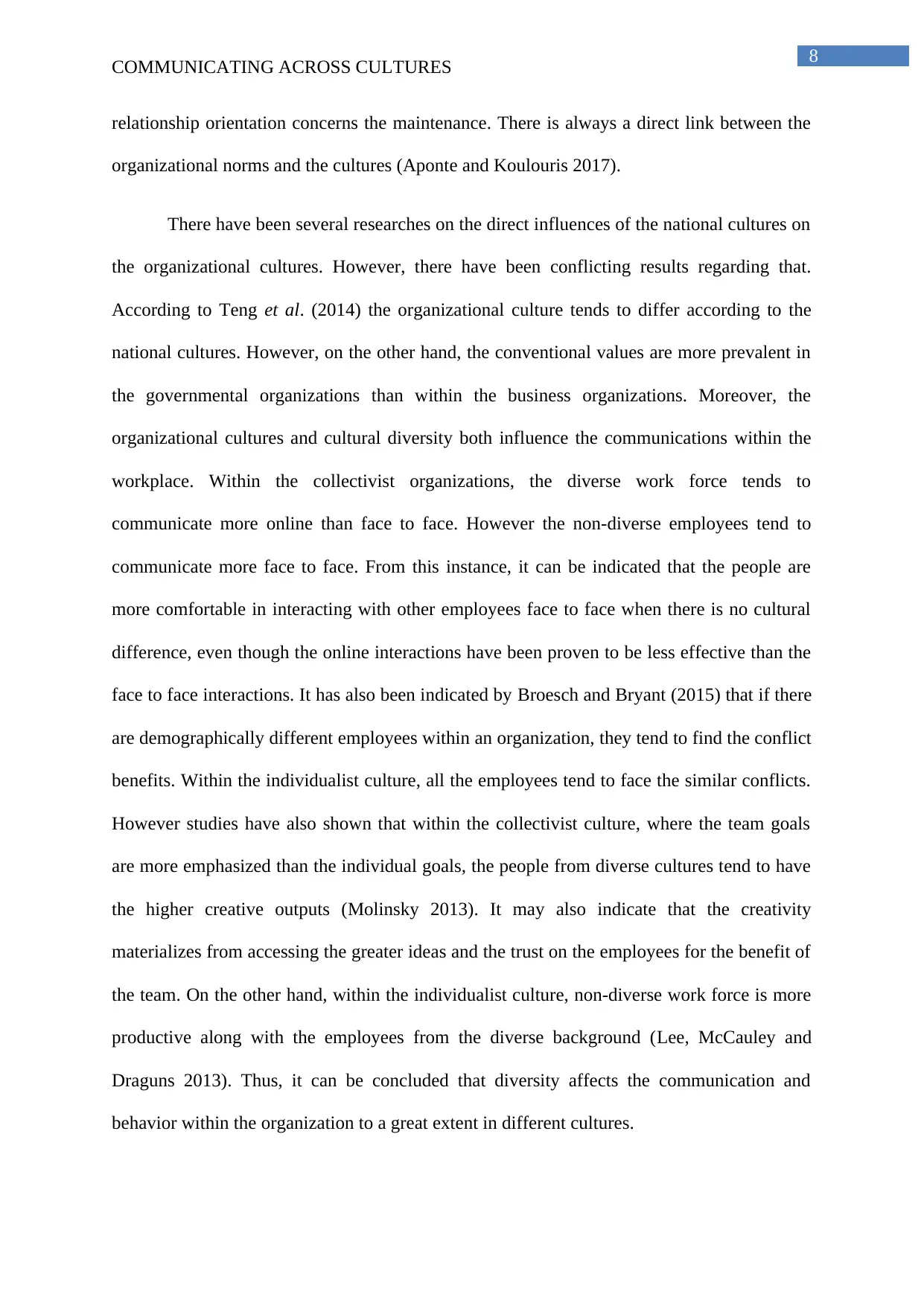
8
COMMUNICATING ACROSS CULTURES
relationship orientation concerns the maintenance. There is always a direct link between the
organizational norms and the cultures (Aponte and Koulouris 2017).
There have been several researches on the direct influences of the national cultures on
the organizational cultures. However, there have been conflicting results regarding that.
According to Teng et al. (2014) the organizational culture tends to differ according to the
national cultures. However, on the other hand, the conventional values are more prevalent in
the governmental organizations than within the business organizations. Moreover, the
organizational cultures and cultural diversity both influence the communications within the
workplace. Within the collectivist organizations, the diverse work force tends to
communicate more online than face to face. However the non-diverse employees tend to
communicate more face to face. From this instance, it can be indicated that the people are
more comfortable in interacting with other employees face to face when there is no cultural
difference, even though the online interactions have been proven to be less effective than the
face to face interactions. It has also been indicated by Broesch and Bryant (2015) that if there
are demographically different employees within an organization, they tend to find the conflict
benefits. Within the individualist culture, all the employees tend to face the similar conflicts.
However studies have also shown that within the collectivist culture, where the team goals
are more emphasized than the individual goals, the people from diverse cultures tend to have
the higher creative outputs (Molinsky 2013). It may also indicate that the creativity
materializes from accessing the greater ideas and the trust on the employees for the benefit of
the team. On the other hand, within the individualist culture, non-diverse work force is more
productive along with the employees from the diverse background (Lee, McCauley and
Draguns 2013). Thus, it can be concluded that diversity affects the communication and
behavior within the organization to a great extent in different cultures.
COMMUNICATING ACROSS CULTURES
relationship orientation concerns the maintenance. There is always a direct link between the
organizational norms and the cultures (Aponte and Koulouris 2017).
There have been several researches on the direct influences of the national cultures on
the organizational cultures. However, there have been conflicting results regarding that.
According to Teng et al. (2014) the organizational culture tends to differ according to the
national cultures. However, on the other hand, the conventional values are more prevalent in
the governmental organizations than within the business organizations. Moreover, the
organizational cultures and cultural diversity both influence the communications within the
workplace. Within the collectivist organizations, the diverse work force tends to
communicate more online than face to face. However the non-diverse employees tend to
communicate more face to face. From this instance, it can be indicated that the people are
more comfortable in interacting with other employees face to face when there is no cultural
difference, even though the online interactions have been proven to be less effective than the
face to face interactions. It has also been indicated by Broesch and Bryant (2015) that if there
are demographically different employees within an organization, they tend to find the conflict
benefits. Within the individualist culture, all the employees tend to face the similar conflicts.
However studies have also shown that within the collectivist culture, where the team goals
are more emphasized than the individual goals, the people from diverse cultures tend to have
the higher creative outputs (Molinsky 2013). It may also indicate that the creativity
materializes from accessing the greater ideas and the trust on the employees for the benefit of
the team. On the other hand, within the individualist culture, non-diverse work force is more
productive along with the employees from the diverse background (Lee, McCauley and
Draguns 2013). Thus, it can be concluded that diversity affects the communication and
behavior within the organization to a great extent in different cultures.
⊘ This is a preview!⊘
Do you want full access?
Subscribe today to unlock all pages.

Trusted by 1+ million students worldwide
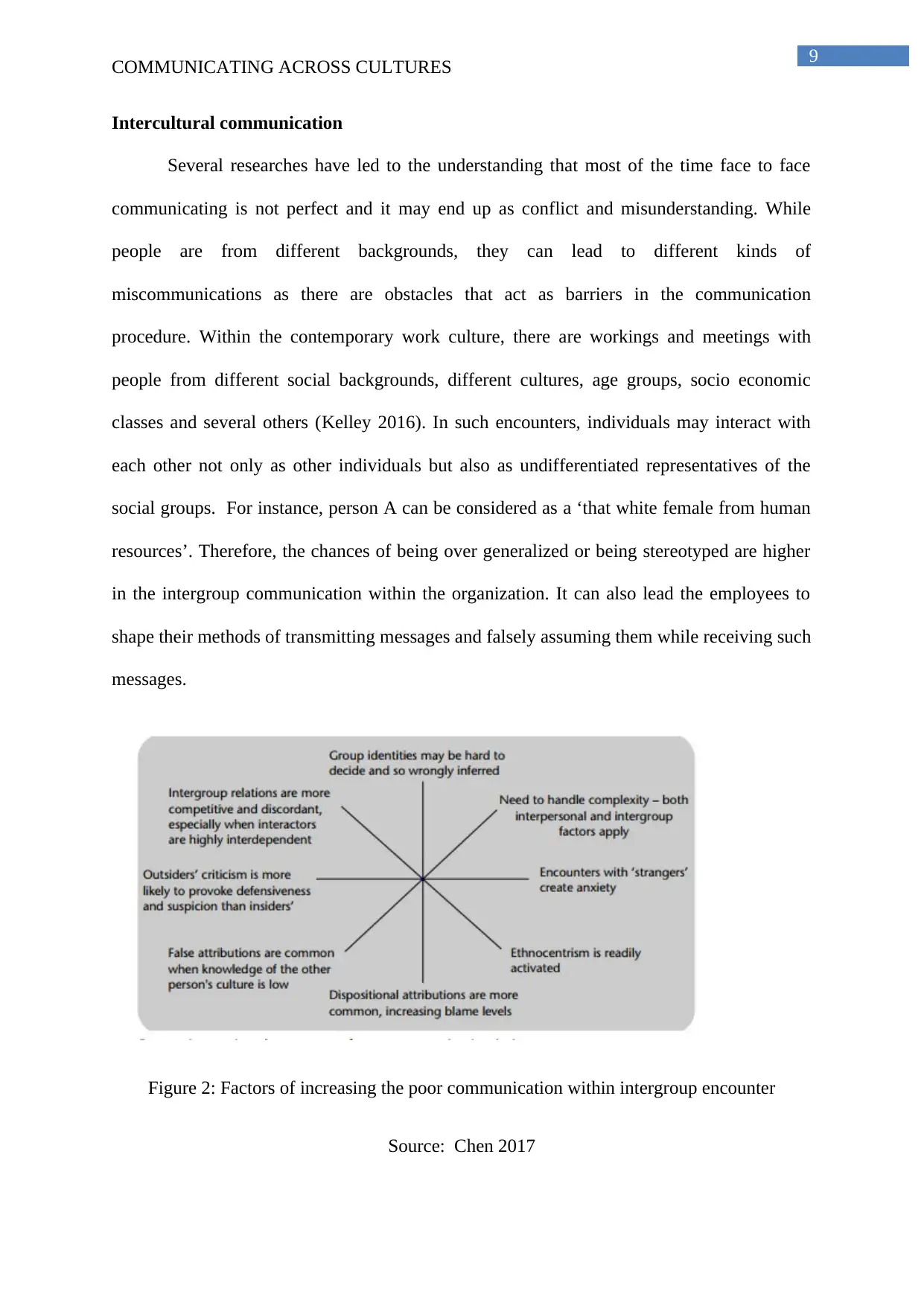
9
COMMUNICATING ACROSS CULTURES
Intercultural communication
Several researches have led to the understanding that most of the time face to face
communicating is not perfect and it may end up as conflict and misunderstanding. While
people are from different backgrounds, they can lead to different kinds of
miscommunications as there are obstacles that act as barriers in the communication
procedure. Within the contemporary work culture, there are workings and meetings with
people from different social backgrounds, different cultures, age groups, socio economic
classes and several others (Kelley 2016). In such encounters, individuals may interact with
each other not only as other individuals but also as undifferentiated representatives of the
social groups. For instance, person A can be considered as a ‘that white female from human
resources’. Therefore, the chances of being over generalized or being stereotyped are higher
in the intergroup communication within the organization. It can also lead the employees to
shape their methods of transmitting messages and falsely assuming them while receiving such
messages.
Figure 2: Factors of increasing the poor communication within intergroup encounter
Source: Chen 2017
COMMUNICATING ACROSS CULTURES
Intercultural communication
Several researches have led to the understanding that most of the time face to face
communicating is not perfect and it may end up as conflict and misunderstanding. While
people are from different backgrounds, they can lead to different kinds of
miscommunications as there are obstacles that act as barriers in the communication
procedure. Within the contemporary work culture, there are workings and meetings with
people from different social backgrounds, different cultures, age groups, socio economic
classes and several others (Kelley 2016). In such encounters, individuals may interact with
each other not only as other individuals but also as undifferentiated representatives of the
social groups. For instance, person A can be considered as a ‘that white female from human
resources’. Therefore, the chances of being over generalized or being stereotyped are higher
in the intergroup communication within the organization. It can also lead the employees to
shape their methods of transmitting messages and falsely assuming them while receiving such
messages.
Figure 2: Factors of increasing the poor communication within intergroup encounter
Source: Chen 2017
Paraphrase This Document
Need a fresh take? Get an instant paraphrase of this document with our AI Paraphraser
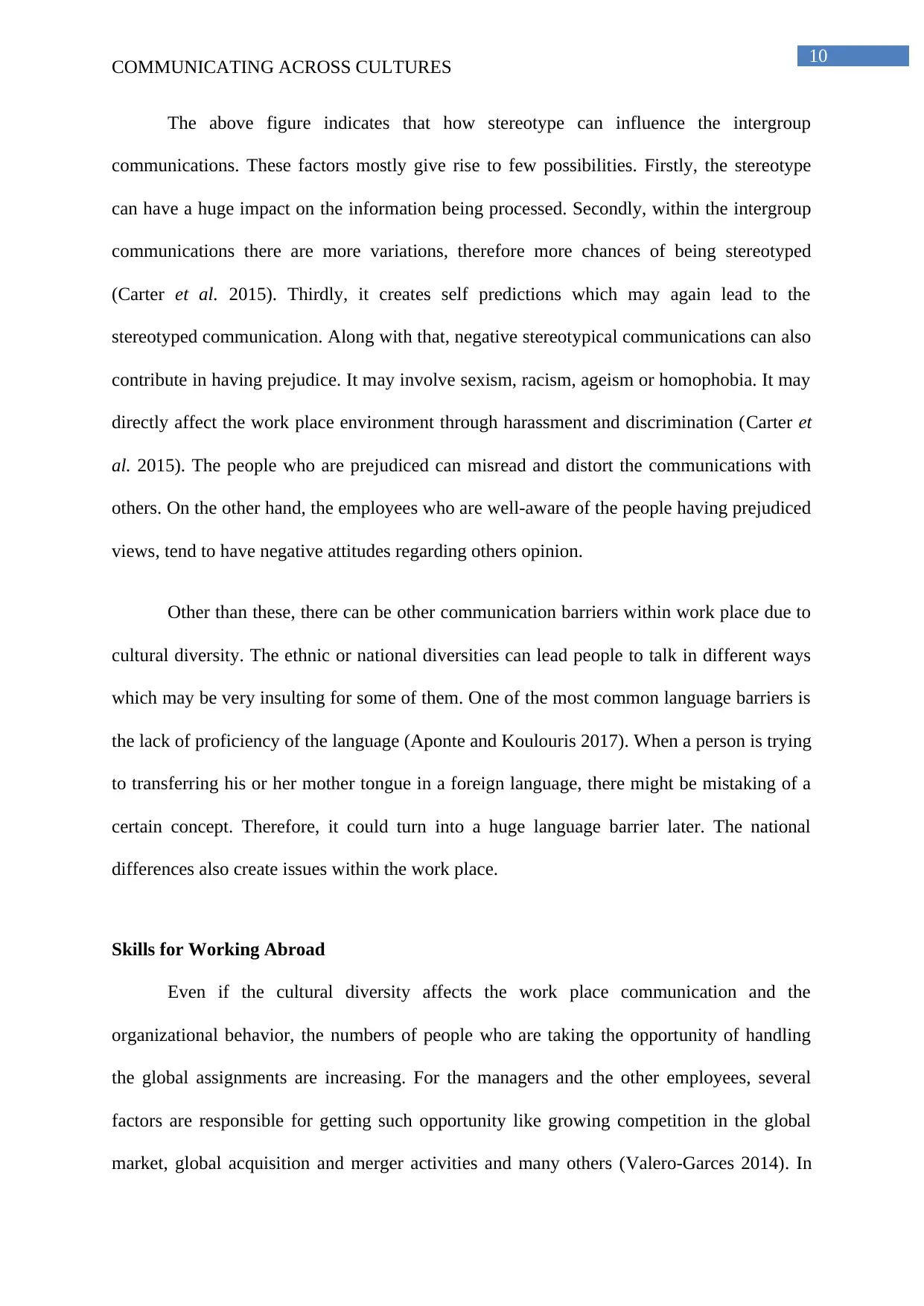
10
COMMUNICATING ACROSS CULTURES
The above figure indicates that how stereotype can influence the intergroup
communications. These factors mostly give rise to few possibilities. Firstly, the stereotype
can have a huge impact on the information being processed. Secondly, within the intergroup
communications there are more variations, therefore more chances of being stereotyped
(Carter et al. 2015). Thirdly, it creates self predictions which may again lead to the
stereotyped communication. Along with that, negative stereotypical communications can also
contribute in having prejudice. It may involve sexism, racism, ageism or homophobia. It may
directly affect the work place environment through harassment and discrimination (Carter et
al. 2015). The people who are prejudiced can misread and distort the communications with
others. On the other hand, the employees who are well-aware of the people having prejudiced
views, tend to have negative attitudes regarding others opinion.
Other than these, there can be other communication barriers within work place due to
cultural diversity. The ethnic or national diversities can lead people to talk in different ways
which may be very insulting for some of them. One of the most common language barriers is
the lack of proficiency of the language (Aponte and Koulouris 2017). When a person is trying
to transferring his or her mother tongue in a foreign language, there might be mistaking of a
certain concept. Therefore, it could turn into a huge language barrier later. The national
differences also create issues within the work place.
Skills for Working Abroad
Even if the cultural diversity affects the work place communication and the
organizational behavior, the numbers of people who are taking the opportunity of handling
the global assignments are increasing. For the managers and the other employees, several
factors are responsible for getting such opportunity like growing competition in the global
market, global acquisition and merger activities and many others (Valero-Garces 2014). In
COMMUNICATING ACROSS CULTURES
The above figure indicates that how stereotype can influence the intergroup
communications. These factors mostly give rise to few possibilities. Firstly, the stereotype
can have a huge impact on the information being processed. Secondly, within the intergroup
communications there are more variations, therefore more chances of being stereotyped
(Carter et al. 2015). Thirdly, it creates self predictions which may again lead to the
stereotyped communication. Along with that, negative stereotypical communications can also
contribute in having prejudice. It may involve sexism, racism, ageism or homophobia. It may
directly affect the work place environment through harassment and discrimination (Carter et
al. 2015). The people who are prejudiced can misread and distort the communications with
others. On the other hand, the employees who are well-aware of the people having prejudiced
views, tend to have negative attitudes regarding others opinion.
Other than these, there can be other communication barriers within work place due to
cultural diversity. The ethnic or national diversities can lead people to talk in different ways
which may be very insulting for some of them. One of the most common language barriers is
the lack of proficiency of the language (Aponte and Koulouris 2017). When a person is trying
to transferring his or her mother tongue in a foreign language, there might be mistaking of a
certain concept. Therefore, it could turn into a huge language barrier later. The national
differences also create issues within the work place.
Skills for Working Abroad
Even if the cultural diversity affects the work place communication and the
organizational behavior, the numbers of people who are taking the opportunity of handling
the global assignments are increasing. For the managers and the other employees, several
factors are responsible for getting such opportunity like growing competition in the global
market, global acquisition and merger activities and many others (Valero-Garces 2014). In
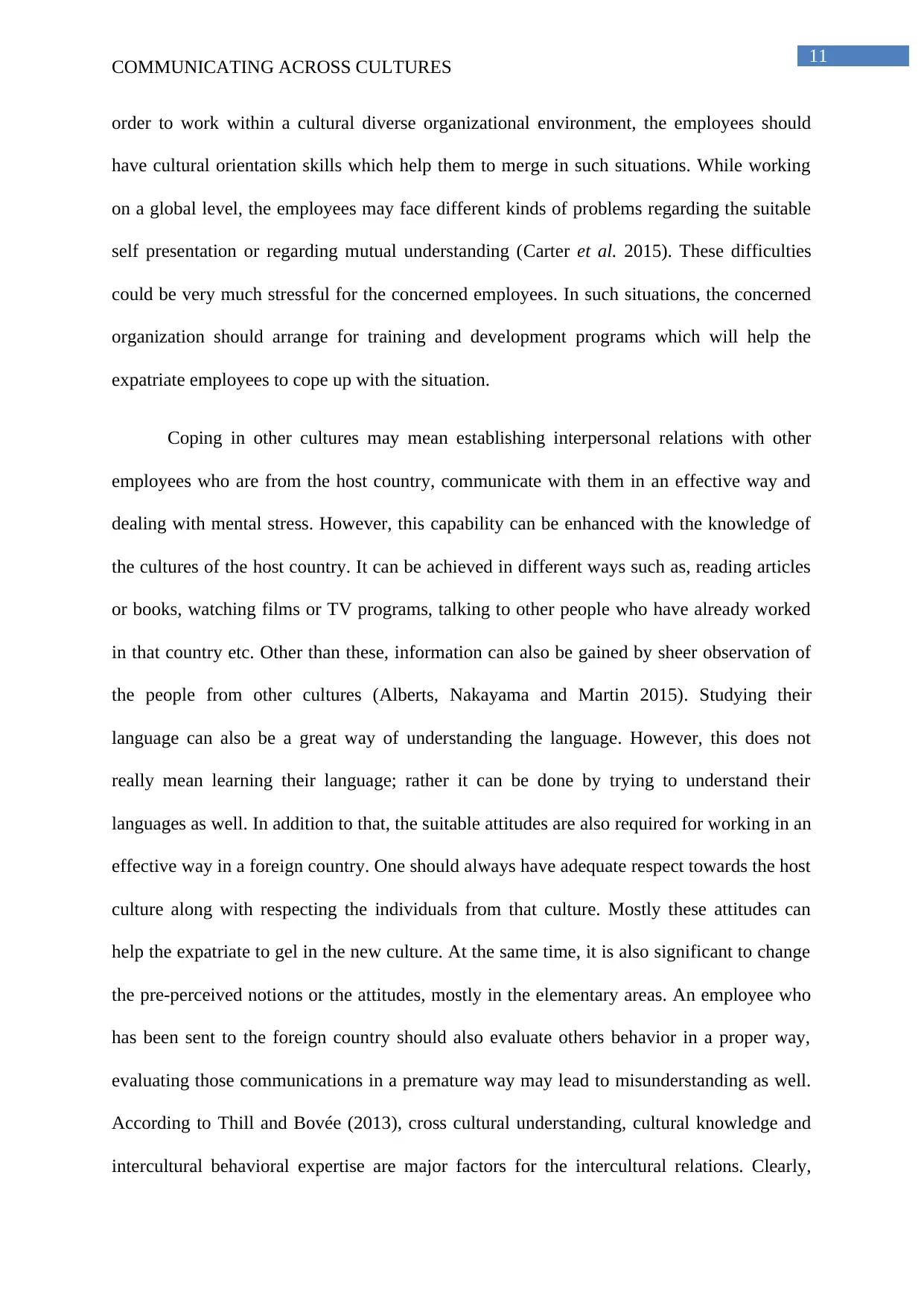
11
COMMUNICATING ACROSS CULTURES
order to work within a cultural diverse organizational environment, the employees should
have cultural orientation skills which help them to merge in such situations. While working
on a global level, the employees may face different kinds of problems regarding the suitable
self presentation or regarding mutual understanding (Carter et al. 2015). These difficulties
could be very much stressful for the concerned employees. In such situations, the concerned
organization should arrange for training and development programs which will help the
expatriate employees to cope up with the situation.
Coping in other cultures may mean establishing interpersonal relations with other
employees who are from the host country, communicate with them in an effective way and
dealing with mental stress. However, this capability can be enhanced with the knowledge of
the cultures of the host country. It can be achieved in different ways such as, reading articles
or books, watching films or TV programs, talking to other people who have already worked
in that country etc. Other than these, information can also be gained by sheer observation of
the people from other cultures (Alberts, Nakayama and Martin 2015). Studying their
language can also be a great way of understanding the language. However, this does not
really mean learning their language; rather it can be done by trying to understand their
languages as well. In addition to that, the suitable attitudes are also required for working in an
effective way in a foreign country. One should always have adequate respect towards the host
culture along with respecting the individuals from that culture. Mostly these attitudes can
help the expatriate to gel in the new culture. At the same time, it is also significant to change
the pre-perceived notions or the attitudes, mostly in the elementary areas. An employee who
has been sent to the foreign country should also evaluate others behavior in a proper way,
evaluating those communications in a premature way may lead to misunderstanding as well.
According to Thill and Bovée (2013), cross cultural understanding, cultural knowledge and
intercultural behavioral expertise are major factors for the intercultural relations. Clearly,
COMMUNICATING ACROSS CULTURES
order to work within a cultural diverse organizational environment, the employees should
have cultural orientation skills which help them to merge in such situations. While working
on a global level, the employees may face different kinds of problems regarding the suitable
self presentation or regarding mutual understanding (Carter et al. 2015). These difficulties
could be very much stressful for the concerned employees. In such situations, the concerned
organization should arrange for training and development programs which will help the
expatriate employees to cope up with the situation.
Coping in other cultures may mean establishing interpersonal relations with other
employees who are from the host country, communicate with them in an effective way and
dealing with mental stress. However, this capability can be enhanced with the knowledge of
the cultures of the host country. It can be achieved in different ways such as, reading articles
or books, watching films or TV programs, talking to other people who have already worked
in that country etc. Other than these, information can also be gained by sheer observation of
the people from other cultures (Alberts, Nakayama and Martin 2015). Studying their
language can also be a great way of understanding the language. However, this does not
really mean learning their language; rather it can be done by trying to understand their
languages as well. In addition to that, the suitable attitudes are also required for working in an
effective way in a foreign country. One should always have adequate respect towards the host
culture along with respecting the individuals from that culture. Mostly these attitudes can
help the expatriate to gel in the new culture. At the same time, it is also significant to change
the pre-perceived notions or the attitudes, mostly in the elementary areas. An employee who
has been sent to the foreign country should also evaluate others behavior in a proper way,
evaluating those communications in a premature way may lead to misunderstanding as well.
According to Thill and Bovée (2013), cross cultural understanding, cultural knowledge and
intercultural behavioral expertise are major factors for the intercultural relations. Clearly,
⊘ This is a preview!⊘
Do you want full access?
Subscribe today to unlock all pages.

Trusted by 1+ million students worldwide
1 out of 15
Related Documents
Your All-in-One AI-Powered Toolkit for Academic Success.
+13062052269
info@desklib.com
Available 24*7 on WhatsApp / Email
![[object Object]](/_next/static/media/star-bottom.7253800d.svg)
Unlock your academic potential
Copyright © 2020–2025 A2Z Services. All Rights Reserved. Developed and managed by ZUCOL.




